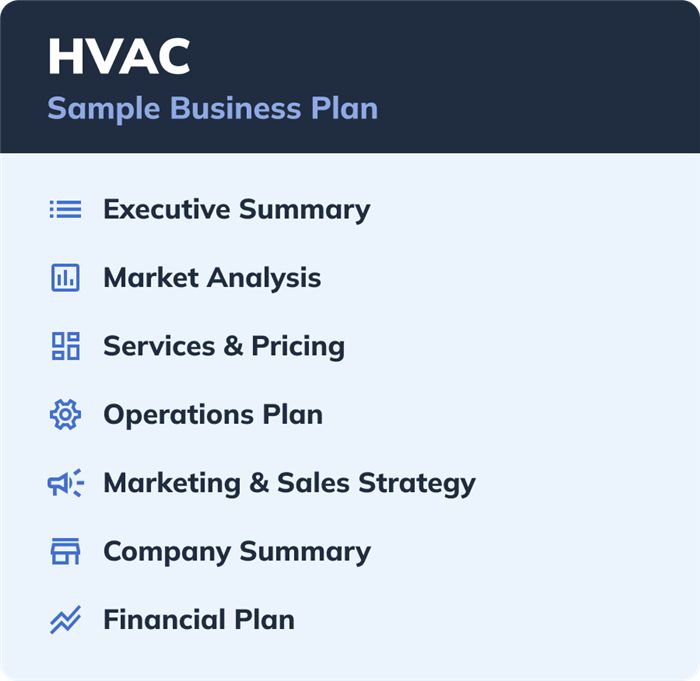No one wants to endure extreme temperatures. In the United States, 3 million heating and air conditioning systems are replaced annually, making the HVAC industry a major employer with over 1.5 million workers and generating more than $150 billion in revenue. However, starting or expanding an HVAC installation and maintenance business requires more than just technical skills. A well-written business plan is essential for aligning your services with the local market and securing financing. This article provides guidance on creating an effective HVAC business plan that highlights your expertise and assures investors of your profitability in the long term.
Key components of an HVAC business plan include:
3. HVAC Services and Pricing
4. Operations Plan
5. Marketing and Sales Strategy
6. Company Summary and Funding Needs
7. Financial Plan and Forecasts
Consider the full range of services you can offer, such as installation, maintenance, repair, and product sales. Including these options in your plan will help evaluate additional revenue streams and ways to enhance customer value. Be sure to outline strategies for each service you choose to provide.

Contents
The 7 Elements of an Effective HVAC Business Plan
1. Executive Summary
The executive summary outlines your HVAC business’s vision, emphasizing your unique value proposition and competitive advantages.
Write a mission statement that describes your business’s purpose, such as providing energy-efficient and environmentally sustainable HVAC systems or offering top-notch customer service for residential and commercial customers.
Touch on key factors for your business’s success, such as location, service offerings, and staff.
2. Market Analysis
Conduct a thorough market analysis to understand the needs of customers in your target area and identify potential sales opportunities.
Research the market to identify target customer segments, their specific needs, and preferences. Consider demographic details, purchasing behaviors, and the size of your target market.
Provide an overview of the competitive landscape, highlighting key players, their market positioning, and industry trends.
3. HVAC Services and Pricing
List the full range of HVAC services your business plans to provide, including installation, maintenance, and repair services for heating, ventilation, and air conditioning systems.
Outline your pricing strategy and how it aligns with market expectations and customers’ willingness to pay.
4. Operations Plan
Detail the day-to-day operational aspects of your business, including service delivery, logistics, equipment, and business policies.
Coordinate with employees to ensure they have the necessary equipment and information for job sites.
5. Marketing and Sales Strategy
Identify effective marketing channels for reaching your target market and outline your strategies for investing in these channels
Consider different marketing tactics based on your product/service offerings.
6. Company Summary
Detail your business model, legal structure, and geographical location.
Explain how your services address specific customer needs or market gaps.
Highlight key roles and expertise of your management team.
7. Financial Plan
Present detailed financial projections for your HVAC business, including startup costs, revenue streams, and funding requirements.
Ensure your financial plan demonstrates your profitability and ability to generate a profit.
Key Considerations for Writing an HVAC Business Plan
1. Go Deep with Your Market Research
Utilize data from public sources to understand the number of households and commercial properties in your area that may need HVAC services.
2. Make Your Credentials Clear
Highlight your team’s expertise, certifications, and accreditations.
3. Professional Training and Standards
Document your plans for ongoing training on HVAC technologies and safety standards.
4. Supplier Relationships and Inventory
Detail your plans for sourcing HVAC systems and logistical arrangements for job site deliveries.
5. Accounts Receivable and Accounts Payable
Incorporate realistic financial projections considering delayed payments for services and settlement of equipment expenses.
Download Your Free HVAC One-Page Sample Business Plan
Download your free HVAC business plan sample or explore the gallery for other industry-specific plans.
Writing a business plan for your HVAC business increases your chances of success and helps ensure a thorough understanding of all aspects of your operation.
Hello!
I’m Andrew Brooks, a seasoned finance consultant from the USA and the mind behind phonenumber247.com.
My career is built on a foundation of helping individuals and businesses thrive financially in an ever-changing economic landscape. At phonenumber247.com, my aim is to demystify the complex world of finance, providing clear, actionable advice that can help you navigate your financial journey with confidence. Whether it’s personal finance management, investment strategies, or understanding the nuances of market dynamics, I’m here to share insights and tools that can propel you towards your financial goals.
Welcome to my digital space, where every piece of advice is a step closer to financial clarity and success!
